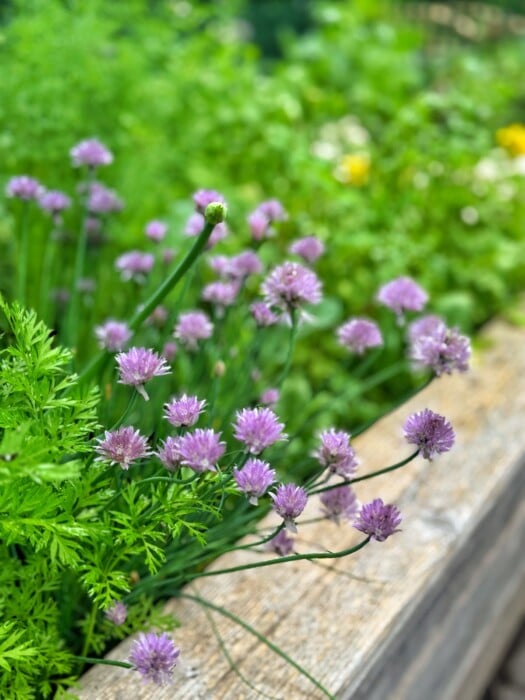Transform your fall leaves into nutrient-rich “black gold” for your garden. Learn how to make leaf mold with this easy-to-follow guide.
In zone 6b New Jersey, the abundance of fallen leaves each autumn presents a golden opportunity for gardeners. Instead of viewing them as a chore, we can transform these leaves into a valuable resource: leaf mold.
Leaf mold is simply decomposed leaves, and it acts as a remarkable soil amendment, improving soil structure, boosting moisture retention, and suppressing weeds. It’s an easy and sustainable way to enhance your garden’s health.
In this guide, we’ll cover everything you need to know about leaf litter mulch, from its differences compared to compost to the simple steps for making your own. Whether you have a large yard overflowing with leaves or a small garden space, let’s turn this fall’s abundance into next spring’s bounty.
(Posts on stacyling.com may contain affiliate links. Click HERE for full disclosure.)

What is Leaf Mold?
Leaf mold is the result of decomposed leaves. It’s a fantastic soil amendment that’s incredibly easy to make and significantly improves your garden soil’s quality.
Unlike regular compost, which typically includes a mix of green and brown materials like kitchen scraps and yard waste, leaf litter compost consists solely of leaves.
The process of making leaf litter mulch is sometimes referred to as “leaf mold composting,” although it’s not technically composting in the traditional sense since it doesn’t involve the same microbial breakdown.

Leaf Mold vs. Compost
Compost is made when organic materials like food scraps decompose over time. The decomposition creates what we gardeners call “black gold” because it’s high in nutrients that enrich overall soil quality and promote happy, healthy plants. Read this article for my best compost recipe.
Leaf mold differs from regular compost in a few key ways:
- Ingredients: Leaf mold consists solely of leaves, while regular compost includes a mix of green and brown materials.
- Decomposition Process: Leaf mold decomposes primarily through fungal action, whereas regular compost relies on a mix of bacteria and fungi.
- Nutrient Content: Leaf mold has fewer nutrients than regular compost but excels at improving soil structure and moisture retention.
- Maturation Time: Leaf mold takes longer to mature, typically between six months to two years, compared to the quicker maturation of regular compost.
I use both leaf litter mulch and compost in my garden to feed my perennials, shrubs, and trees, rather than relying on fertilizers. To me, feeding plants starts with building really good soil quality as opposed to pumping them up with artificial nutrition.

Why Is Leaf Mold Good for Your Garden?
While leaf mold doesn’t offer as much in the way of direct soil nutrition as compost, it significantly increases water retention and improves overall soil structure. This helps plant roots stay cooler during hot, dry weather, which is a huge benefit in regions with intense summers.
Here are some of the specific benefits of composting leaves in your garden:
- Improved Soil Structure: Leaf mold enhances soil structure by increasing its water-holding capacity and aeration. This makes it easier for plant roots to access nutrients and water.
- Weed Suppression: A layer of leaf mold on your garden beds can help suppress weeds, reducing the need for constant weeding.
- Environmentally Friendly: Leaf mold composting is an eco-friendly way to reuse yard waste, reducing the need for landfill disposal and chemical fertilizers.
- Sustainable Gardening: Using leaf mold aligns with sustainable gardening practices, as it encourages a natural, low-impact approach to soil improvement.

How to Use Leaf Mold
Once decomposed, you can dig leaf mold into your garden beds or apply it as a mulch. It’s beneficial in garden beds and can also be added to planters to help retain moisture. Making leaf litter mulch is so easy that it’s a no-brainer during fall cleanup. All you really need is a little bit of space to store your leaves and let them transform into this valuable soil amendment.
How to Make Leaf Mold
Making leaf mold is incredibly simple and requires minimal effort. There are two primary methods: the pile method and the plastic garbage bag method. The best method for you will depend on the space you have available.
Supplies Needed
- Leaves (preferably shredded or partially decomposed for faster results)
- Rake or leaf blower
- Water
- Designated area or bin for the pile method
- Plastic garbage bags for the bag method

The Pile Method
- Gather Leaves: Collect fallen leaves, ideally in the fall when they are abundant. You can use a rake or leaf blower to gather them efficiently.
- Create a Leaf Pile: Pile the leaves in a corner of your garden or a designated compost bin. If using a bin, ensure it has holes for aeration. Moisten the leaves thoroughly.
- Let Nature Work: Unlike regular compost, leaf mold doesn’t require turning or adding other materials. Simply let the leaves sit and decompose naturally.
- Monitor Moisture: Check the pile periodically and add water if it becomes dry. Maintaining moisture is essential for decomposition.
- Patience is Key: Leaf mold takes time to mature, typically between one to two years. Smaller leaves and shredded leaves will decompose faster than whole large leaves. During this time, the leaves will break down and turn into a crumbly, dark substance.

The Plastic Garbage Bag Method
- Collect Leaves: Gather fallen leaves and place them in plastic garbage bags.
- Moisten and Seal: Dampen the leaves inside the bag, then seal it tightly.
- Puncture for Airflow: Poke a few small holes in the bag to allow for some air circulation.
- Monitor and Maintain Moisture: Check the bags periodically and add water if the leaves dry out.
- Wait for Decomposition: Leaf mold in bags typically takes about a year to form.
Using Leaf Mold in Your Garden
Once your leaf mold is ready, you can use it in various ways to benefit your garden:
- Mulch: Spread a layer of leaf mold around your plants to suppress weeds, retain moisture, and regulate soil temperature.
- Soil Amendment: Mix leaf mold into your garden beds to improve soil structure, drainage, and water retention.
- Potting Mix: Add leaf mold to your potting mix to enhance its texture and moisture-holding capacity.
- Around Trees and Shrubs: Apply leaf mold around the base of trees and shrubs to provide a slow-release source of nutrients and improve soil health.

Final Thoughts on Making Leaf Mold
As a gardener in zone 6b New Jersey, I’ve come to appreciate the magic of composting leaves. It’s a simple yet powerful way to harness the natural cycle of the seasons and turn fall’s abundance into a gift for my garden.
The process of making leaf litter mulch might require a bit of patience, but the rewards are well worth the wait. Witnessing those once-vibrant leaves transform into rich, dark soil is truly satisfying. And knowing that I’m improving my garden’s health in a sustainable way makes it even more special.
So, the next time you see those leaves piling up, don’t just see a chore – see an opportunity. Gather those leaves, give them a little space and time, and watch as they turn into gardening gold. Your plants will thank you, and you’ll feel good knowing you’re doing your part to create a more eco-friendly garden.
Happy gardening!
Do you compost leaves in your garden too? If so, how do you prefer to make it? I would love to know more in the comments below.
For more information about composting leaves, please read this article from the Penn State Cooperative Extension.
Thanks for stopping by the blog today!
Enjoy your day! xoxo























